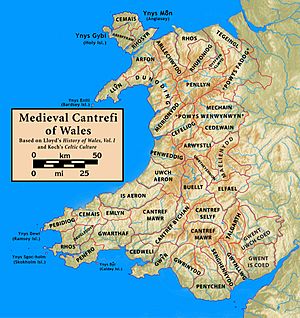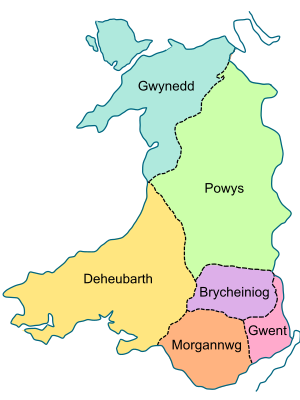Arwystli facts for kids
Arwystli was an important area in central Wales during the Middle Ages. It was a "cantref," which was like a large district or county back then. Arwystli was located near the start of the River Severn.
For hundreds of years, different groups fought over Arwystli. The main groups were the Kingdom of Powys, the Kingdom of Gwynedd, and powerful Norman lords called Marcher Lords. These lords controlled lands along the border with England. Many small battles happened here.
Later, in the 1500s, laws called the Laws in Wales Acts changed how Wales was governed. Arwystli, like many other old districts, was split up into smaller parts.
Contents
Arwystli's Beginnings
During the time of Roman rule, Arwystli was part of the land belonging to the Ordovices. They were a Celtic tribe who lived in much of northern Wales. We don't know exactly when Arwystli became its own distinct area. Its name comes from a person named Arwystl. The first time Arwystli is mentioned in writing is in the Domesday Book from the 1000s. It was called the "hundred of Arvester" then.
Even though much of Arwystli was moorland (open, uncultivated land), it had good farmland in the river valleys. It was also important because it offered a way to travel between central Wales and the Welsh Marches (the borderlands with England). At some point, Arwystli was divided into two smaller areas called "commotes": Arwystli Is Coed and Arwystli Uwch Coed. These names mean "Arwystli Below the Wood" and "Arwystli Above the Wood." Important towns in the area included Talgarth, Llandinam, Llanidloes, and Caersws.
Who Controlled Arwystli?
Arwystli was once seen as part of the Kingdom of Powys. But over time, its local rulers started to connect more with the Kingdom of Gwynedd. For example, Arwystli became part of the Diocese of Bangor, which covered Gwynedd, instead of the Diocese of St Asaph, which was linked to Powys. Because of this, Arwystli often became a battleground between the two Welsh kingdoms.
In the late 1000s, a Norman leader named Roger de Montgomerie took control of Arwystli. However, another Norman, Robert of Rhuddlan, who controlled most of North Wales, also claimed it. Roger's family held Arwystli until the early 1100s, when Welsh lords took it back. For the next few centuries, Powys and Gwynedd continued their fierce struggle, and the local rulers of Arwystli often switched sides.
The King's Dispute Over Arwystli
The arguments over Arwystli played a big part in leading up to the 1283 conquest of Wales by Edward I of England. In 1263, Llywelyn ap Gruffudd, who was the Prince of Wales and ruled Gwynedd, agreed that Gruffydd ap Gwenwynwyn should control Arwystli. Gruffydd was a Marcher Lord of a part of Powys called Powys Wenwynwyn.
However, in 1274, Llywelyn changed his mind. He claimed Arwystli as part of his own Principality of Wales. Gruffydd protested this decision. In 1277, Llywelyn took his case to King Edward I, who was his overlord, hoping for a quick solution. The 1277 Treaty of Aberconwy promised that Edward would fairly consider Llywelyn's case. It also said that disputes should be settled "according to the laws of Wales for cases arising in Wales."
Llywelyn argued that Arwystli was part of Wales, so the dispute should be decided by Welsh law, not by English common law used in the Marches. But King Edward used this case to try and make the Prince of Wales seem less important. He insisted that Llywelyn had to present his complaint like any other person, instead of getting special treatment as one of the king's main vassals (important noblemen). This insult made many Welsh people angry at the king, which helped cause the revolt in 1282. After Edward conquered Wales the next year, he supported Gruffydd's claim, which meant Powys officially gained control of Arwystli.
Arwystli Changes Hands Again
In the late 1300s, Arwystli, along with smaller lordships like Caereinion and Cyfeiliog, was taken from the Cherleton family by Edmund Mortimer. Later, Edward Charleton took back these lands in 1403, during the Glyndŵr Rising (a major Welsh rebellion). His family eventually sold Arwystli to the English Crown during the time of Henry VIII.
King Henry's Laws in Wales Acts divided Arwystli into smaller areas called manors. The old cantref was reorganized as Arwystli Hundred, and later it was known as Llanidloes Hundred. It was part of the historic county of Montgomeryshire until 1974. Then, the area became part of the new county of Powys.



